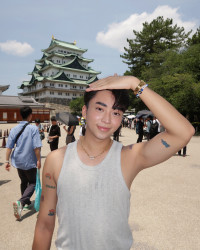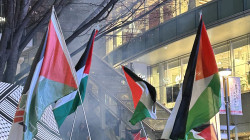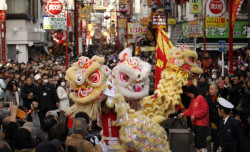
Originally published on metropolis.co.jp on September 2008

Photos by Carlo Niederberger
“May the world become peaceful,” reads a message tied to a colorful wreath of carefully folded paper cranes. Made by a class of sixth graders from Nara Prefecture, this offering is draped against a crumbling concrete slab, one of six that form a concave structure resembling an enormous bowl standing three stories high. Several of these vaults face each other in rows divided by a narrow, rocky path that’s partially overgrown by weeds. The chipped inner wall of the chambers are still mostly scorched black—reflecting the intensity with which the Allied armies destroyed the facility that for years had manufactured lethal gas used by Imperial Japanese forces.
A cool ocean breeze blowing through the compound brings respite as I emerge back into sunlight to a cacophony of cicadas in the surrounding forest. From this vantage point, I peer down at a golden beach on the northwestern tip of Okunoshima.

Photo by Carlo Niederberger
Barely 4.3 kilometers in circumference, the diminutive island belongs to the municipality of Takehara in Hiroshima Prefecture. It lies discreetly 3km off the coast, one of many such islands scattered in the powerful current streams of the emerald Seto Inland Sea.
Okunoshima’s remoteness is one of the reasons the Japanese army began using it in 1918 as a research center for its chemical warfare program. The Geneva Protocol, which entered into force in 1928, forbade the use of chemical and biological weapons, but did not forbid their production, storage or transfer. Nevertheless, the military authorities shrouded the program in secrecy, even going so far as to produce maps that omitted all mention of Okunoshima. From 1929 until the end of World War II, more than 6,000 tons of poison gas were manufactured on the island.
A short distance away from the ruins lies a path leading to the island’s peak. As I pursue the trail, climbing first through dense foliage and then across a steep, open hillside, I come across gigantic concrete silos peering out from the pines and blueberry shrubs, looking out to sea. Nearby, a stone staircase covered by moss leads down to a series of immaculately preserved brick vaults and pyramidal turrets that eerily resemble the Mayan ruins of Central America.
Even prior to the Russo-Japanese War (1904-05), Okunoshima caught the eyes of the military planners who installed this defensive gun emplacement, one of a series located at elevated points across the island. In time, the guns were removed for use in subsequent war efforts, leaving only the bolts protruding from their platforms and the auxiliary facilities, which, ironically, were built from tiles imported from the Russian Empire.

Photo by Carlo Niederberger
This green, idyllic island makes no secret of the aggression and conflict that are deeply entrenched in its history. In fact, one of the first sites to greet visitors after alighting from the ferry is a defunct power station used during World War II, its façades now mostly coated in a gigantic web of leaves. But Okunoshima reveals, in equal measure, how quickly peacetime can transform even the most warlike settings. As one of Japan’s 36 officially designated kyukamura (“villages of rest and recreation”), the island welcomes a reported 100,000 visitors each year. Okunoshima’s leisure facilities include a full-service hotel, an onsen, several tennis courts and a swimming pool, as well as several beaches that allow for fishing and snorkeling.
Having descended from the peak, I walk along the paved road running along the perimeter of the island toward the pier. Families ride by on rented bicycles and children play along stretches of fine sand where it meets the cool, crystalline water. Along the edges of the road, small blue crabs crawl in the shadows of rocks while a shiny lizard slithers through the crevices, and the singing of a Japanese nightingale occasionally complements the perpetual cries of the cicadas. Nearing the pier, I arrive at a clearing where dozens of rabbits roam freely, unabashedly approaching tourists waiting to board the ferry returning to the mainland. These endemic creatures, of which there are now hundreds, are the mascots of Okunoshima, descendants of a small group of rabbits released on the island in 1971 by a local primary school.
Playfully chasing each other and leaping high into the air, they seem to be answering to the prayers for peace of all those who come to witness the scars of war.
Okunoshima can only be accessed by a ferry service linking the island to Tadanoumi station on the Kure rail line. Visitors from Tokyo can take the Kodama shinkansen and transfer to the Kure line at Hiroshima’s Mihara station, or take the quicker Nozomi bullet train to Fukuyama station, and change to a local train. The Okunoshima Poison Gas Museum, opened in 1988, is located near the island’s vacation facilities, and provides an overview of the Imperial Japanese Army compound, as well as the
effects of poison gas on humans. Rooms at the Kyukamura Ohkunoshima start at under ¥8,000 per person (0846-26-0321, http://tinyurl.com/poisongas).







